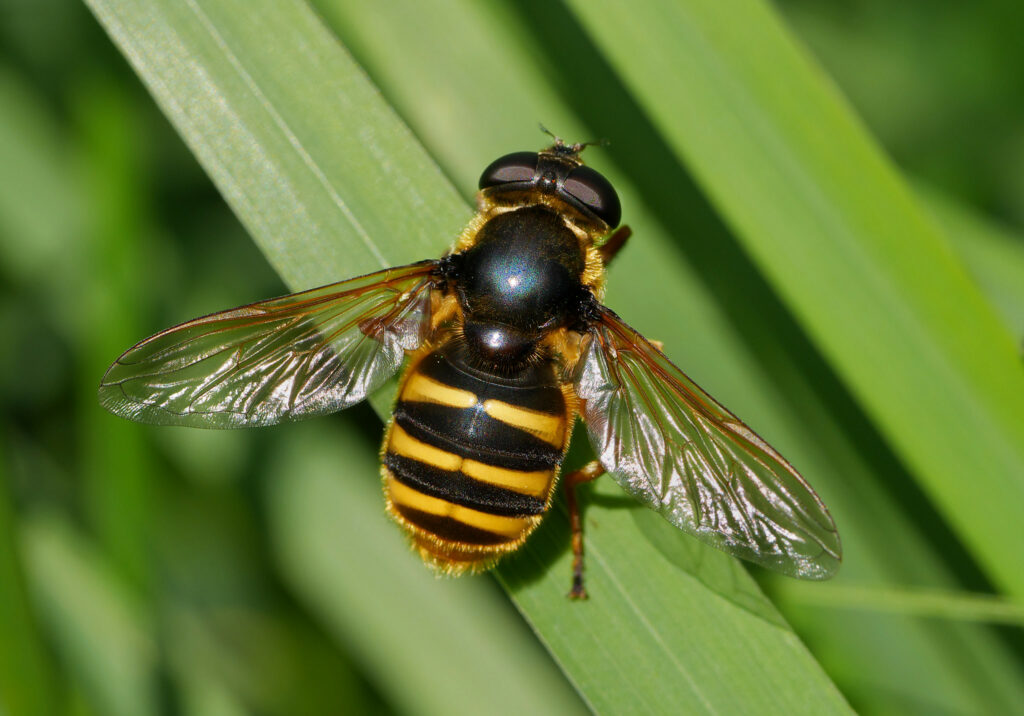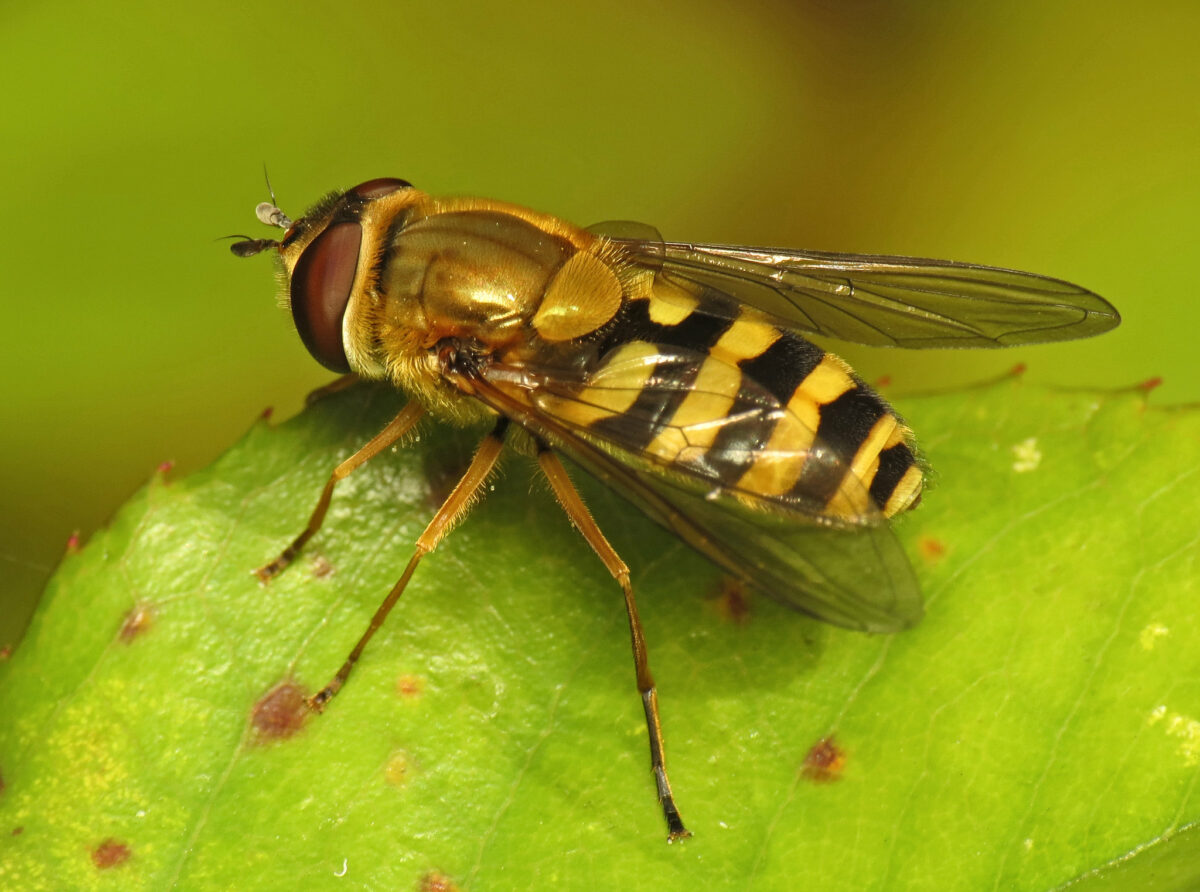With approximately 7,000 species, the Diptera (true flies) are one of the biggest insect orders in Britain and Ireland, second only to Hymenoptera (the bees, wasps and ants). Of these species, over 280 belong to the family Syrphidae, the hoverflies. Known as ‘flower flies’ in other parts of the world, hoverflies are frequent visitors to flowering plants and are a familiar sight in our gardens and woodlands, and a wide range of other habitats. You would be forgiven for mistaking a hoverfly for a bee or wasp, as some species are amazing mimics in terms of both their appearance and behaviour, although some are more convincing than others.
Hoverflies are important, and often overlooked, pollinators, and their larval stages are incredibly diverse. Some larvae are predatory, feeding on aphids or eating grubs within the nests of ants, social bees or wasps, while others feed on the roots, stems or leaves of plants, or on dead and decaying organic matter, such as rotting wood or material collected in rot holes in trees.
Although many hoverflies are brightly coloured or distinctively patterned, there are plenty of inconspicuous species that resemble flies in other families. The first step is therefore to determine that a fly is in fact a hoverfly. In general hoverflies lack the strong bristles we see in other flies, such as the house fly, but the key characteristic is their wing venation. Unlike other flies, hoverflies have a ‘false vein’ on their wing, and although this is a difficult feature to get an eye for initially, it can be obvious in good photos and becomes easier to spot with practice. Another clue is in the name; hoverflies are remarkable fliers and many species are able to hold their position in flight for an incredible length of time.
Hoverfly identification can be difficult, and in some cases it is necessary to inspect a specimen under a microscope for a positive ID. There are many garden visitors that are more straightforward, however, and with a good field guide, a hand lens and a camera to take clear photos with, you can easily get started in learning more about this attractive group of insects. There are fantastic resources online too, such as the UK Hoverflies group on Facebook, which provides help with identification and allows members to share their observations.
This is the first of two hoverfly identification guides, and in both of these blogs we will be covering the more common species that you are likely to encounter in your garden or local patch.
Eristalis tenax
Distribution: Widespread throughout Britain and Ireland. E. tenax is thought to be the most widespread hoverfly species in the world.
Habitat: A wide range of habitats including gardens, woodlands and meadows.
What to look for: A convincing honey-bee mimic that can be easily told from other species of Eristalis by three obvious characteristics: a thickened, curved hind tibia; a broad, dark facial stripe; and vertical stripes of dark hairs on the eyes.
Months active: Present throughout the year, but most frequently recorded between February and April, and June and November.
Did you know: Females hibernate over the winter, and males are increasingly being recorded hibernating during warmer winters in southern England. The aquatic larvae, or ‘rat-tailed maggots’, live in wet, decaying vegetation

The Eristalis genus includes a number of common species that are likely to be encountered in gardens, such as E. pertinax and E. arbustorum. The May issue of British Wildlife magazine includes an article by Roger Morris and Stuart Ball that provides an introduction to the Eristalis genus, and includes an identification key to the ten Eristalis species that occur in the UK.
Myathropa florea
Distribution: Widespread throughout Britain and Ireland.
Habitat: A variety of habitats, but found in woodlands especially.
What to look for: Similar to some Eristalis species, Myathropea florea is a distinctive black-and-yellow species with a bat-like pattern on its thorax, although this can vary and cause confusion in less clearly marked individuals.
Months active: April to October.
Did you know: Like other species in the Eristalini tribe, M. florea larvae are known as ‘rat-tailed maggots’ and are found in wet hollows containing decaying vegetation, although they have been reported making use of any containers holding water and dead vegetation, such as buckets or water butts.

Syrphus ribesii
Distribution: Widespread throughout Britain and Ireland.
Habitat: A number of habitats including woodlands, gardens and hedgerows.
What to look for: Females can be easily identified by their completely yellow hind femora, although males are harder to distinguish from two other common Syrphus species, S. torvus and S. vitripennis. Male S. ribesii can be separated from S. torvus by their bare eyes, but a microscope is needed to reliably separate males of S. ribesii and S. vitripennis.
Months active: From March to November, with peaks in May–June and July–September.
Did you know: Male S. ribesii will emit a noticeable humming noise from tree canopies, caused by vibrating their wings at a high frequency when resting.

Merodon equestris
Distribution: Widespread in Britain and Ireland, but less abundant in parts of Scotland.
Habitat: Often recorded in gardens and urban areas.
What to look for: A hairy bumblebee mimic that has swollen hind femora with triangular projections – a characteristic unique among bumblebee mimics. M. equestris can occur in a range of colour forms to mimic different bumblebee species.
Months active: Between April and September, with a peak in late May and early June.
Did you know: The larvae develop in the bulbs of many different bulb-forming plants, but they are especially associated with daffodils and can be a pest in some cases. They are thought to have been introduced to Britain in the 19th century in daffodil bulbs.

Platycheirus albimanus
Distribution: Widespread throughout Britain and Ireland.
Habitat: Woodland edges and hedgerows, and often seen in gardens.
What to look for: Females are easier to recognise due to their yellow legs and silver spots on their black abdomen. Males tend to have bronze-coloured spots, a front tibia that is significantly broader at the end, and front femora that have distinctive clumps of long hairs. It is possible to confuse males with similar species such as P. aurolateralis, P. scutatus, and P. splendidus, and so close examination of the legs is required.
Months active: Between March and November, with peaks between May and June, and July and August.
Did you know: A common garden visitor, particularly in spring, P. albimanus is often found in low vegetation such as nettles or brambles.


Eupeodes corollae
Distribution: Widespread in Britain, although less abundant in northern Scotland.
Habitat: Recorded in almost any habitat, from gardens to mountain tops.
What to look for: Males and females are quite different in appearance, but both have broad yellow markings that reach the edges of the abdomen. The males also have an obvious genital capsule.
Months active: March to November, with a peak between July and August.
Did you know: E. corollae is found in a wide variety of habitats. An influx of migrants or a mass emergence of individuals results in a peak in numbers in midsummer.


Melanostoma mellinum
Distribution: Widespread throughout Britain and Ireland.
Habitat: Grasslands.
What to look for: It is easy to confuse this species with M. scalare, and so close examination is required. In females, the top of the head is a shining black with very narrow dust spots by the eyes, while the abdomen has distinctive yellow markings. Males have a relatively short abdomen and the second and third segments are as wide as they are long.
Months active: April to October, with peaks in May–June and July–August.
Did you know: This is one of the most common hoverfly species in the UK and is often recorded from grasslands, although it can also be found in high numbers in the uplands such as on moorland or mountainsides.

Chrysogaster solstitialis
Distribution: Widespread in Britain and Ireland, but rare in parts of northern Scotland.
Habitat: Woodlands, road verges and hedgerows.
What to look for: A small, dark hoverfly (even the wings are dark) with bright red eyes. Confusion can occur with other Chrysogaster species, or even small house flies.
Months active: May to October, with a peak in July and August.
Did you know: A common woodland species, particularly in damp and shady locations. C. solstitialis is often seen in concentrated numbers on umbellifers such as Hogweed and Angelica.

Rhingia campestris
Distribution: Widespread throughout Britain and Ireland.
Habitat: Woodlands and field edges, but found in a variety of habitats.
What to look for: The long snout and orange abdomen make this an unmistakable species. The only potential for confusion is with the UK’s other Rhingia species, R. rostrata, but the dark edges of the abdomen and overall darker colouration of R. campestris are distinctive.
Months active: April to October, with peaks between May and June, and August to September.
Did you know: The long snout allows R. campestris to feed on plants with deep tubes, such as bluebells, which other hoverflies cannot use. The larvae breed in cow dung, although other breeding habitats are also thought to be used as adults can occur in high numbers where there are few or no cattle.

Sericomyia silentis
Distribution: Widespread in Britain and Ireland, although absent from central England and scarce in south-east England.
Habitat: Acidic, boggy habitats, such as wetlands and heathlands.
What to look for: A large wasp mimic with distinctive black-and-yellow banding – it is very unlikely that this species would be confused with any other hoverfly.
Months active: May to November, with a peak in July.
Did you know: This is a very mobile species, which is often found far from breeding sites. It visits a range of plants, but seems to have a preference for red or purple flowers, such as Devil’s-bit Scabious.

Ferdinandea cuprea
Distribution: Widespread in Ireland, Wales and southern England, but rarely occurs in high numbers.
Habitat: Woodland.
What to look for: Easily recognisable, F. cuprea has a metallic, brassy abdomen with grey longitudinal stripes on the thorax. The thorax also has strong bristles on its side, which is quite uncommon for a hoverfly.
Months active: March to November, with a peak in June.
Did you know: F. cuprea is rarely seen visiting flowers, and is more likely to be seen basking on tree trunks, wooden posts or even telegraph poles.

Suggested reading and equipment:
 Britain’s Hoverflies: A Field Guide
Britain’s Hoverflies: A Field Guide
£24.99
 British Hoverflies: An Illustrated Identification Guide
British Hoverflies: An Illustrated Identification Guide
£37.50

£0.35

Opticron Hand Lens 23mm 10x Magnification
£12.95 £14.95

£31.99
All prices correct at the time of this article’s publication.


